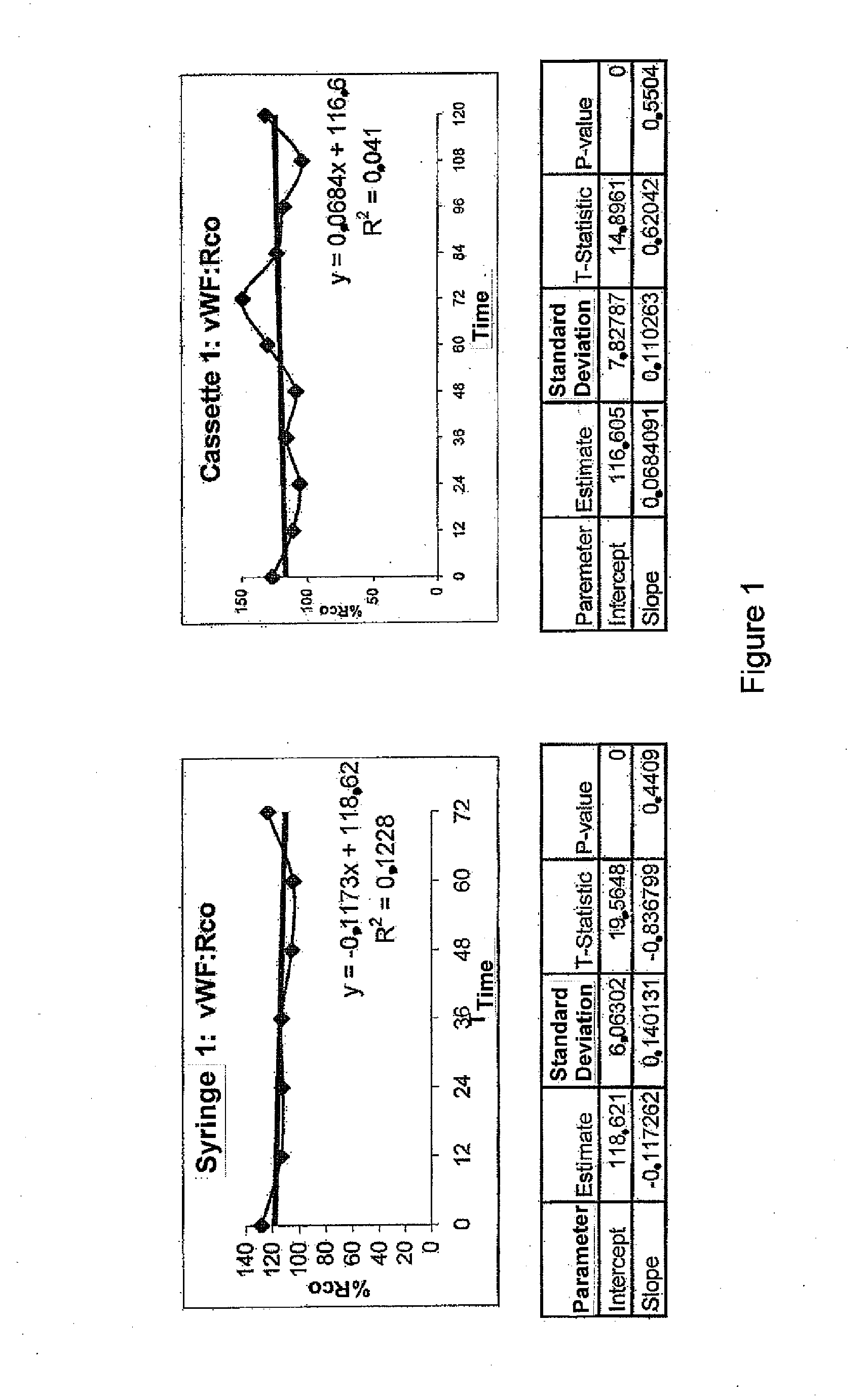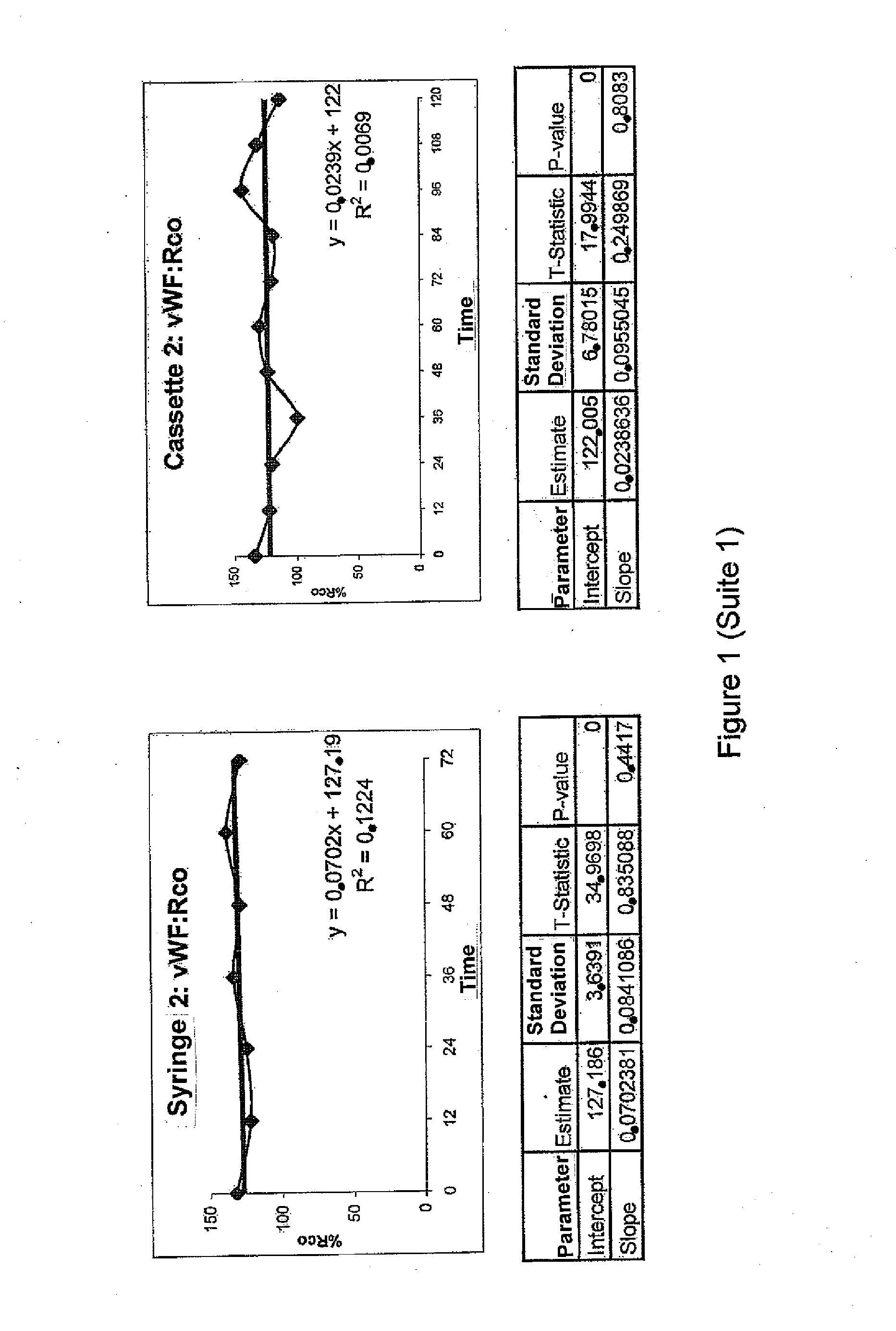Use of a chromatography substrate for reducing the amount of adamts13 in a solution derived from plasma
a plasma and chromatography substrate technology, applied in the field of protein purification, can solve the problems of heterogeneous clinical expression, serious complications, and unstable solution of vwf concentrates, and achieve the effect of reducing the amount of adamts13
- Summary
- Abstract
- Description
- Claims
- Application Information
AI Technical Summary
Benefits of technology
Problems solved by technology
Method used
Image
Examples
example 1
Manufacture of a vWF Concentrate Without ADAMTS13
[0036]Starting Material.
[0037]Blood was collected in the presence of sodium citrate (4%) or an anti-clotting CPD solution (citrate, phosphate, dextrose), and frozen at the latest 6 hours after sampling thereof. Plasma was obtained after centrifuging, and frozen at −60° C. then stored at −35° C. Plasma batches contained from 1800 to 2000 litres and were pooled to batches of 4000 litres for each implementation of the method. For thawing, plasma was placed within a chamber at −7° C. for at least 12 hours to ensure a slow and regular heating-up, then it was thawed in a thermostated chamber at a temperature of 0-2° C., under constant stirring. The cryoprecipitate (which corresponds to about 9 g / litre of plasma) was recovered by cold centrifugation.
[0038]After centrifugation, the recovered cryoprecipitate was re-dissolved and adsorbed onto aluminum hydroxide so as to remove the major contaminants, that is to say the components of the proth...
example 2
Measurement of the ADAMTS13 Amount Reduction in the vWF Concentrate
[0052]The aim of this example is to measure the reduction factor of the ADAMTS13 amount present in a vWF concentrate prepared according to example 1.
[0053]Starting Material.
[0054]Four fractions corresponding to the solutions / concentrates before and after each chromatography step of example 1 as well as an initial plasma fraction were collected. For each fraction, a sample of 1 mL, respectively labelled A, B, C, D and E, was collected.[0055]A: initial plasma[0056]B: cryoprecipitate between solvent / detergent and the first DEAE chromatography[0057]C: eluate from the first DEAE chromatography[0058]D: eluate from the second DEAE chromatography[0059]E: fraction of the vWF-containing gelatin-Sepharose column
[0060]ADAMTS13 Protein Assays.
[0061]The ADAMTS concentration in each sample was measured with an IMUBIND® ADAMTS13 ELISA kit (from American Diagnostica) using rabbit anti-human ADAMTS13 antibodies.
[0062]At the same time,...
example 3
Stability of the VWF Concentrate with no ADAMTS13
[0067]The aim of this example is to evaluate the biological stability after reconstitution of the vWF freeze-dried concentrate without ADAMTS13, prepared according to example 1 in various containers and under routine conditions when effecting dose fractionation into syringes or batchwise, or when administrating the product by a continuous infusion using an infusion pump.
[0068]Material
[0069]Tested drugs: Three different vWF concentrate batches were tested:[0070]Batch #1: vWF:RCo 1010 IU / 10 ml flask[0071]Batch #2: vWF:RCo 1080 IU / 10 ml flask[0072]Batch #3: vWF:RCo: 1000 IU / 10 ml flask
[0073]Infusion material used[0074]Infusion pump CADD PRIZM™ VIP (SIMS Deltec, Inc, St Paul, Minn., USA)[0075]MEDICATION CASSETTE™ 50 ml reservoirs, in polyvinyl chloride[0076]Delt extension cord for pump with 114 cm / 45 in anti-siphon valve in polyvinyl chloride[0077]3P Plastipak 10 ml Luer Lock H810LL Syringes in polypropylene
[0078]Automatic dosing device:...
PUM
| Property | Measurement | Unit |
|---|---|---|
| molecular weight | aaaaa | aaaaa |
| time | aaaaa | aaaaa |
| temperature | aaaaa | aaaaa |
Abstract
Description
Claims
Application Information
 Login to View More
Login to View More - R&D
- Intellectual Property
- Life Sciences
- Materials
- Tech Scout
- Unparalleled Data Quality
- Higher Quality Content
- 60% Fewer Hallucinations
Browse by: Latest US Patents, China's latest patents, Technical Efficacy Thesaurus, Application Domain, Technology Topic, Popular Technical Reports.
© 2025 PatSnap. All rights reserved.Legal|Privacy policy|Modern Slavery Act Transparency Statement|Sitemap|About US| Contact US: help@patsnap.com



